Intel Hades Canyon NUC (NUC8i7HVK) review - powerhinglew
Intel's Pluto Canon is more than a simple successor to its Skull Canyon predecessor, an extreme version of Intel's Close Unit of Computing (NUC). When Skull Canyon launched in 2016, it bucked the mini-PC trend of modest specs designed for general calculation, as an alternative boasting the absolute latest in computer hardware for its size: a 45W quad-heart processor, integrated graphics capable of 1080p play, and a port that supported external graphics. At the time, that ultra-compact mini-PC was unrivaled.
The Aidoneus Canon NUC brings its ain first: a single, Intel-produced chip (cipher-titled Kaby Lake-G) that marries an Intel mobile CPU with an AMD Radeon RX Vega M transferable GPU. It's silicon that can handle heavy-duty tasks without break much of a stew.
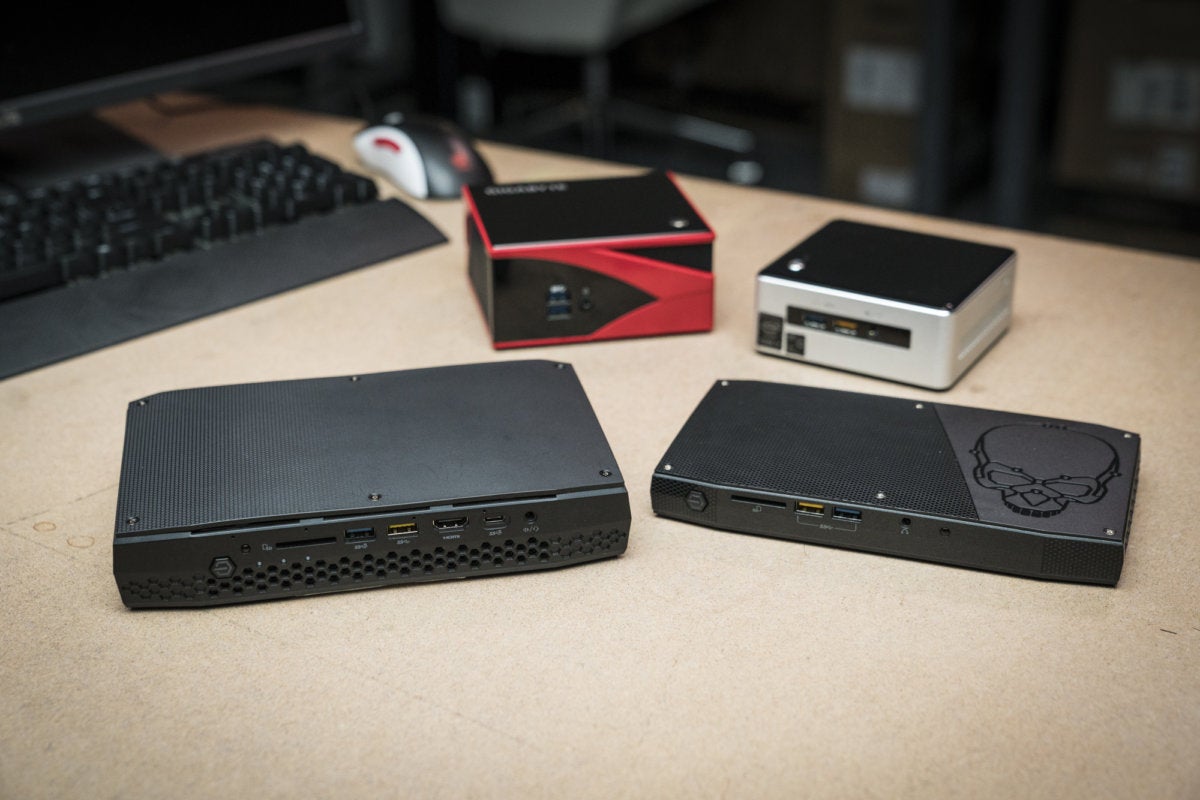 Adam Patrick Murray / IDG
Adam Patrick Murray / IDG Clockwise from top left: Gigabyte Brix GB-BXA8-5557, Intel NUC5i7RYH, Intel NUC6i7KYK (Skull Canyon), Intel NUC8i7HVK (Hades Canyon)
Price, specs, and ports
Hades Canyon comes in two configurations—ane marketed as an overclockable gambling machine (the NUC8i7HVK), and the other as a content-creation organisation (the NUC8i7HNK). We received the gaming version for review, which is the higher-ending option and costs $1,000 for just the bare-bones kit.
Adding storage, memory, and an operating system bequeath hike the monetary value by at the least a hardly a hundred dollars, given today's inflated prices for SSDs and RAM. Our review whole, which came pre-equipped with a 118GB Intel Optane 800P-serial publication SSD, 512GB Intel 545s-series SSD, 16GB of Kingston HyperX DDR4/3200 RAM, and a Windows 10 Pro license, would set us back away almost $1,550 in aggregate.
Each configuration comes equipped with a different combination of Intel processor and AMD GPU. (To get a thorough rundown on Kaby Lake-G, you crapper read our fuzee that followed the CES proclamation of the chips.) Inside the NUC8i7HVK is the 100W Core i7-8809G, which houses a quad-core, eight-thread maneuverable CPU and Radeon RX Vega M GH graphics.
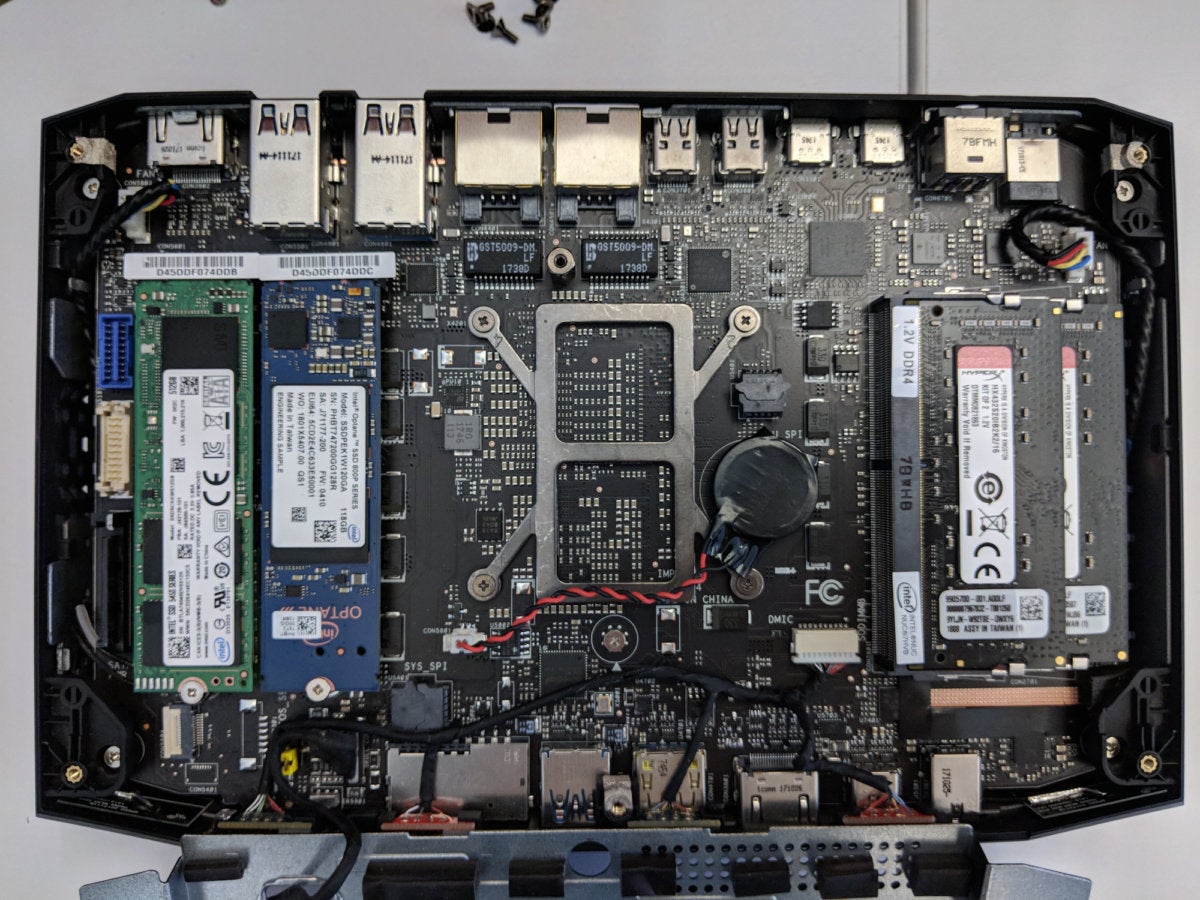 Alaina Yee / IDG
Alaina Yee / IDG Getting inside this NUC requires removing the top lid and a metal home plate. Intel includes a hex wrench and spare screws for the top lid, but you'll still need a Phillips screwdriver for the metal plate.
The processor is equivalent to Intel's 45W H-series mobile CPUs (complete with active integrated graphics that keister deal video playback and other basic tasks), though its mightiness requirements differ slenderly. The actual power consumed varies conditional CPU and GPU loads, as Intel designed the package with a shared power budget and uses what it calls dynamic tuning to allow each component a greater ability to extend to its max boost. As mentioned previously, IT's overclockable, with broth settings of a 3.1GHz base time and 4.2GHz Turbo. Intel says that it's gotten up to 4.7GHz when overclocking.
Coupled to the CPU by eight PCIe lanes is the Vega M GH, which runs at a 1,063MHz base time and 1,190MHz boost clock. The GH variant of Vega M comes with 24 compute units and 4GB of HBM2 retentivity, along with a slightly faster memory bandwidth of 204.8GB per indorse. It also supports outturn to sise 4K displays simultaneously, with up to five at 60Hz and the sixth at 30Hz. Like the CPU, you can overclock the Vega M GH and the HBM2 memory.
Backing this star CPU-GPU pairing is a whole array of equally fireball technology. Two M.2 slots can take SATA 6Gbps Oregon x4 PCIe Gen 3 (AHCI or NVMe) drives in either a 42mm Oregon 80mm length, with the option to run two drives in Foray into 0 or Foray 1. An Intel Wireless-AC 8265 card handles some 802.11ac 2×2 Wi-Fi and Bluetooth 4.2. Two SO-DIMM sockets accept up to 32GB of DDR4/2,400MHz Random access memory at 1.2V, and support overclocked DDR4 RAM. In that respect's justified a light beam-forming, far-theater of operations, quad-mic array included this time approximately.
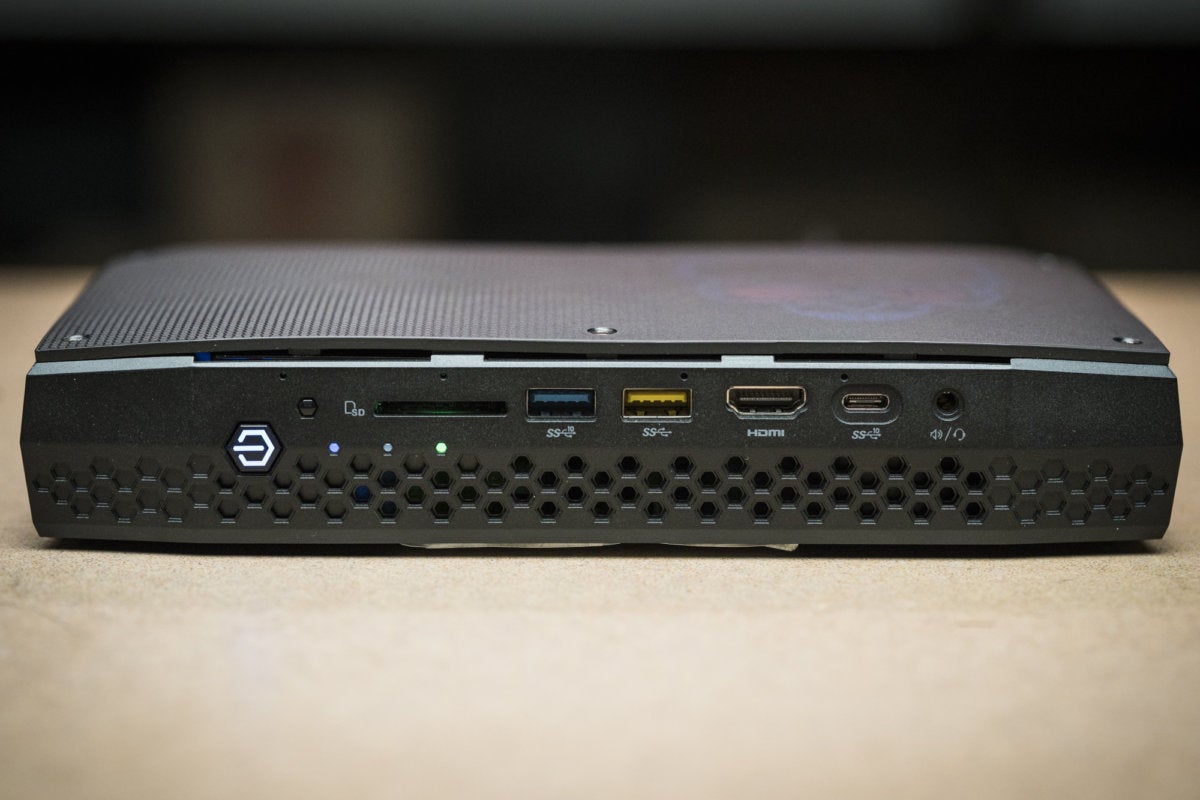 Adam Patrick Gilbert Murray / IDG
Adam Patrick Gilbert Murray / IDG For ports, Intel's crammed even more of them into Hades Canyon. Because this NUC is larger than Skull Canyon—at 8.70 x 5.59 x 1.54 inches (1.2L), it's roughly the size of a VHS tape—you get multiples of almost everything. On the front you'll find an SDXC slot, USB 3.0 charging left, USB 3.1 Gen 2 (10Gbps) Type A, HDMI 2.0a, USB 3.1 Gen 2 (10Gbps) Type C, and a 3.5mm stereo headset jackass.
On the hinder side there's a 3.5mm speaker/TOSLINK jack, the connector for the 230W power supply, two Thunderbolt 3 ports, ii Miniskirt DisplayPort 1.2, 2 gigabit ethernet, four USB 3.0 Type A, and HDMI 2.0a. The two Thunderbolt 3 ports each support 4 PCIe lanes, but they're connected to the same controller. As a result, bandwidth may be shared if some ports lam at the same time using a x4 configuration. As with the Skull Canyon NUC, you may run external graphics over the Thunderbolt 3 ports.
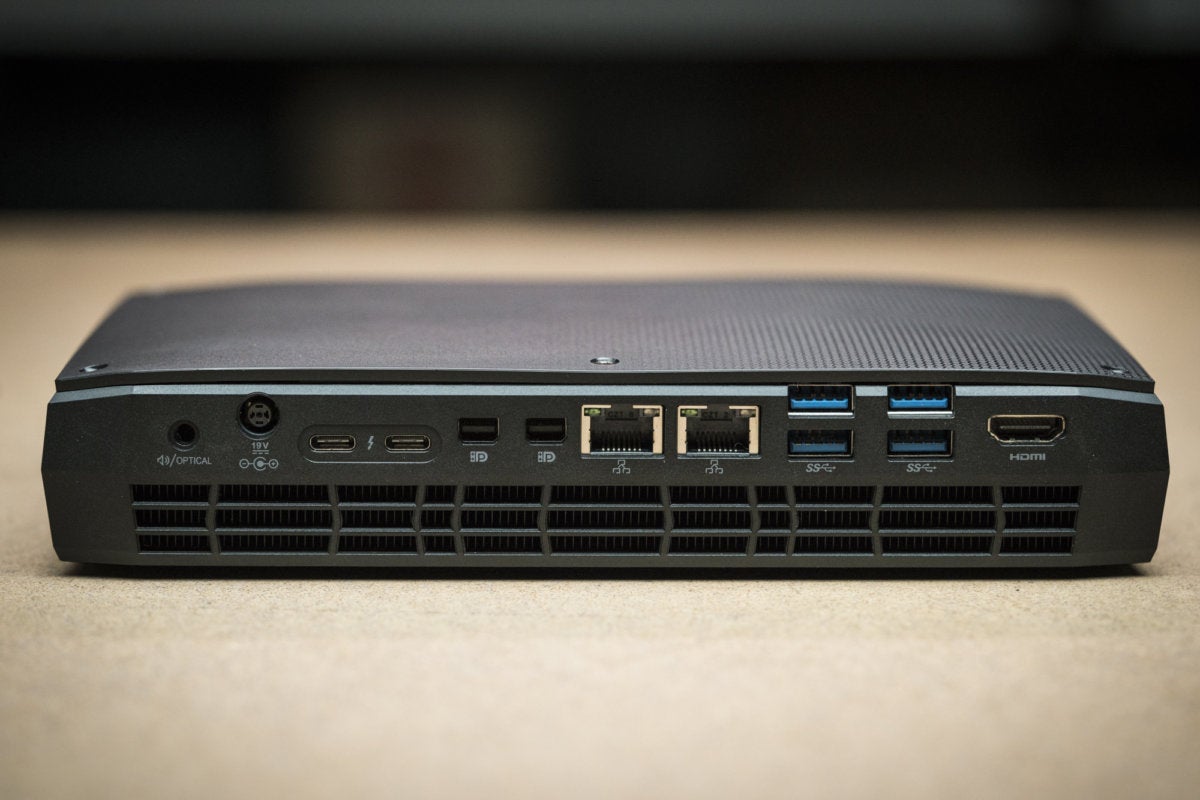 Adam Patrick Murray / IDG
Adam Patrick Murray / IDG You can expand the enumerate of USB ports if you utilize the I/O header, which carries signals for two USB 3.0, cardinal USB 2.0, CEC, and the strawma panel.
The chassis once again features a expendable top lid, though this sentence it's been upgraded to feature article customizable RGB LED lights that illuminate the contour of a skull. The default is a red-and-depressing color scheme, but it's easily metamorphic direct included software system to other hues and with different incandescence patterns. You also have the option to change the color of the status LEDs on the front panel, which are also RGB.
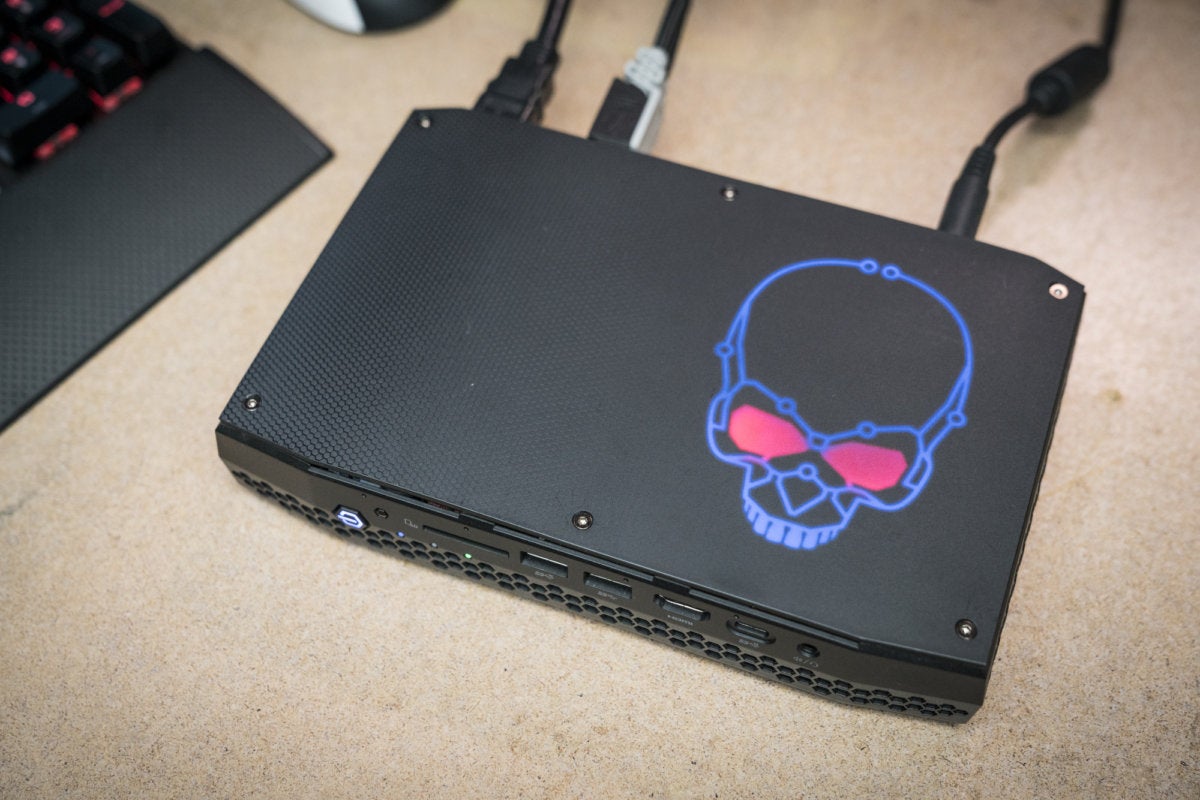 Adam Patrick Murray / IDG
Adam Patrick Murray / IDG Our review social unit didn't admit a dispense with eyelid, but if you don't like the skull you tail end simply turn off the lights. The box did go with a hex sprain, some spare screws, and a VESA mounting plate.
Performance
Aside and large, the NUC8i7HVK's Intel-AMD combination delivers a solid experience. Let's probe the gaming performance first.
3DMark Fire Strike
We'll embark on with 3DMark's Fire Strike mental test, a synthetic benchmark that simulates gaming at 1080p on Medium settings. Because this is the first time we've seen the Radeon RX Vega M in the desert, I chose to isolate just the artwork score in order to see where it ranked among other mobile GPUs. This way, the latent influence of the CPU happening the ranking is minimized.
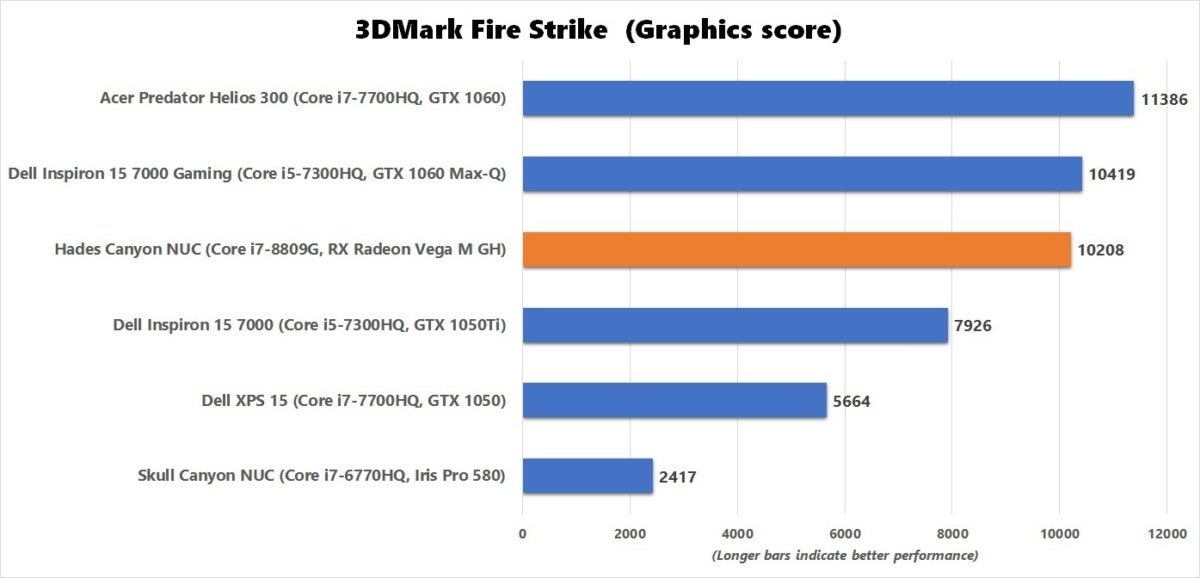 PCWorld
PCWorld As you can see, performance roughly falls between that of an Nvidia GTX 1050 Ti and an Nvidia GTX 1060 Max-Q part. That's about where I estimated, specially given the fairly famed jump in carrying out between a 1050 Cordyline terminalis and a full 1060. The Vega M GH seems to skew closer to the 1060 Grievous bodily harm-Q (which is a stepped-down version of the 1060) than the 1050 Ti, though.
Observe: American Samoa you may have already figured out, all of the comparability systems in these charts are laptops—that's where the bulk of our testing of motile parts lies. It's not a perfect apples-to-apples compare, given that laptops accept a different set of demands for cooling versus mini-PCs, only it still provides a decent internal representation of standing.
Rise of the Tomb Raider
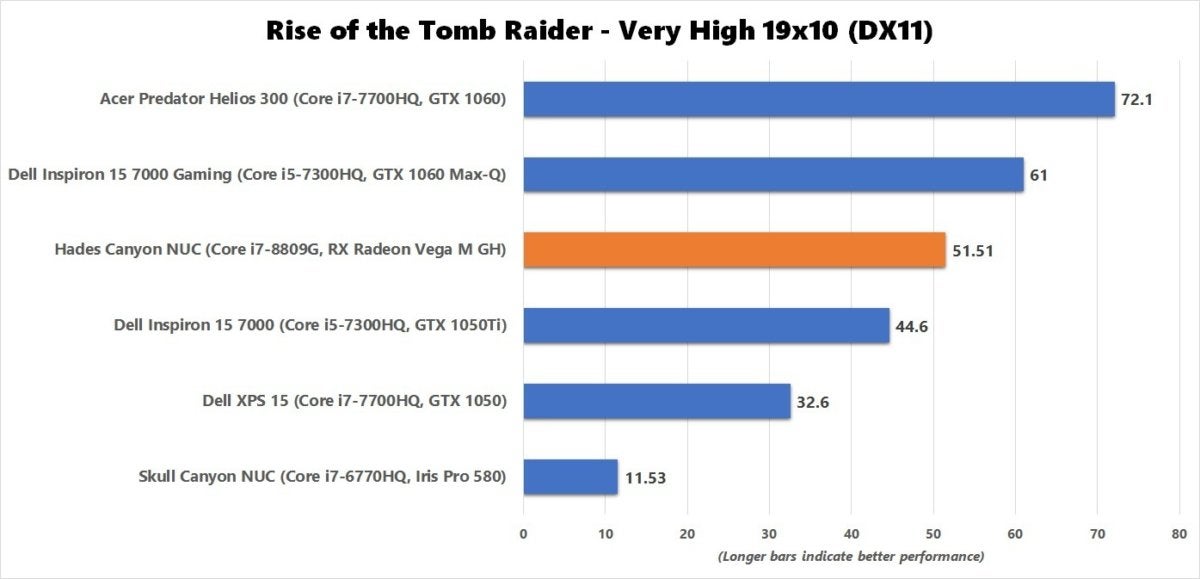 PCWorld
PCWorld In actualised games, the NUC8i7HVK largely maintains that position just under systems with the GTX 1060 Grievous bodily harm-Q. In Rise of the Grave Raider, which is a semi-Recent blockbuster game that posterior still crusade budget-range GPUs, we got an average out of 51 fps along the Rattling Peaky preset.
That should be unruffled sufficient for many folk, but if not, the job's easily solved in one of two ways. The to a greater extent provocative pick: Hooking up the NUC8i7HVK to a FreeSync monitor. Ilk other AMD GPUs, the Lope Felix de Vega Carpio M GH supports those adaptable-refresh displays. (It supports features like Radeon Shudder equally well.) You fanny also drop the graphics setting down to High, which will then bump up the frame rate to about 63 Federal Protective Service.
Middle-earth: Shade off of State of war and PUBG
Simply what approximately now's games? To answer that question, I fired up FRAPS in ii contemporary games: last nightfall's Middle-earth: Shadow of War and PlayerUnknown's Battlegrounds.
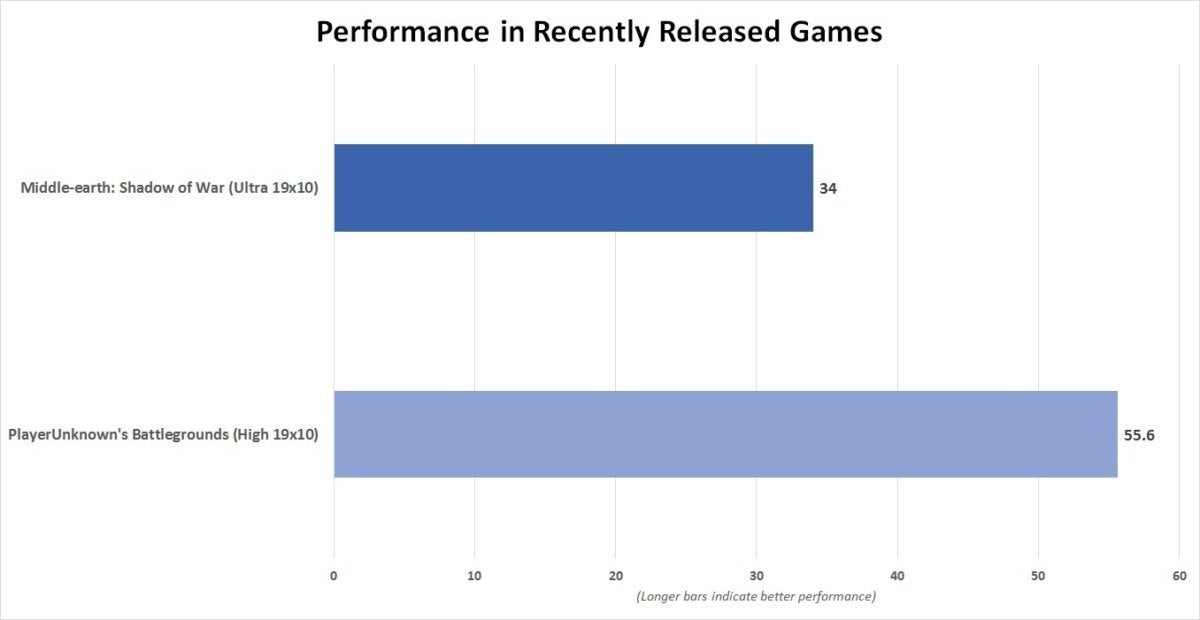 PCWorld
PCWorld I wasn't capable to benchmark these same games on different systems we had in the office in the fourth dimension available. These standalone results practise show, however, that this variant of Scheol Canyon throne hold its own in contemporary games. Note that the PUBG experience Crataegus oxycantha not be quite as good during hairier, frenzied moments: As a whole noob, I ended up mostly wandering maps on the empty outer edges during those unaccompanied matches.
Again, remember that FreeSync is an alternative. As the NUC8i7HVK ages, FreeSync will be the cheaper option to hold out games feeling buttery-graceful. (You can besides get an external artwork identity card setup, but that'd demand a much greater cash outlay compared to the $100 to $150 you'd make up these days for an entry-level, 24-inch FreeSync monitor.)
Middle-earth: Shadow of Mordor and Tomb Despoiler
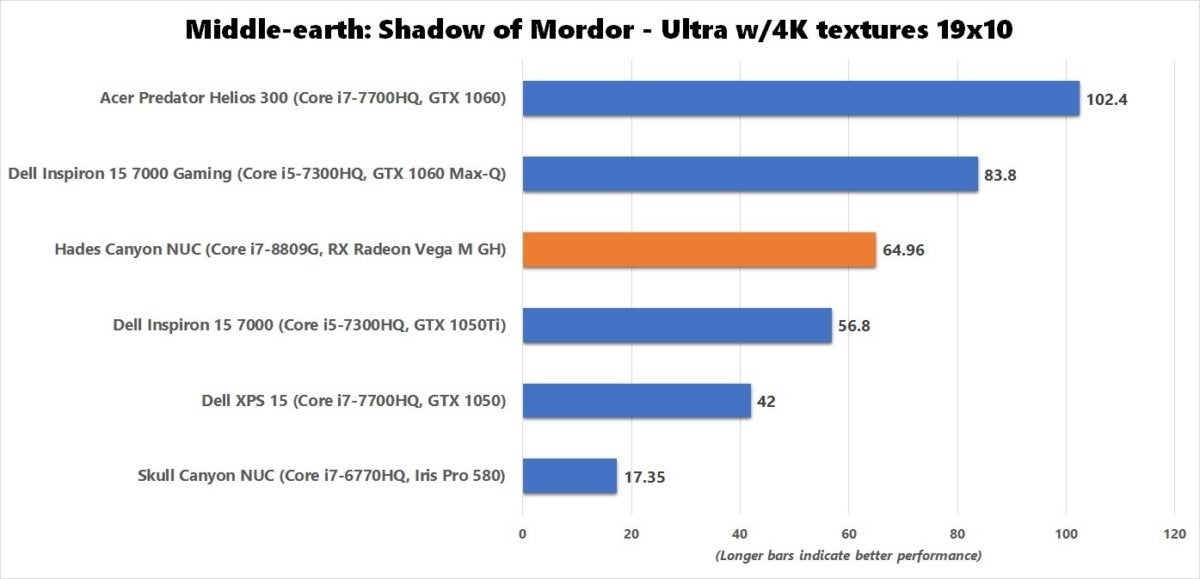 PCWorld
PCWorld As you'd expect by this power point, the NUC8i7HVK promptly handles older AAA games. In 2014's Middle-earth: Shadow of Mordor, it held steady at 64 fps on the Ultra planned (and with the 4K texture throng in use). It did almost as well in 2013's Tomb Raider on the Ultimate preset, with a issue of 61 fps. If you have a log of games to chaw through with, they shouldn't peril this tiny Personal computer.
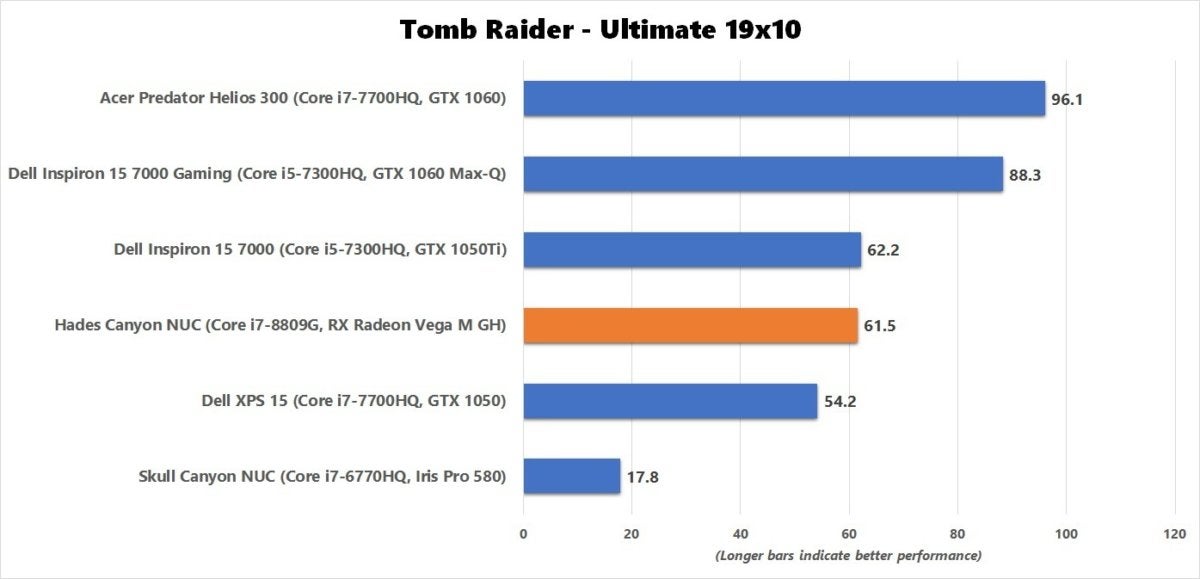 PCWorld
PCWorld (Incidentally, if you're questioning why the Tomb Raider result skewed finisher to GTX 1050 Ti performance instead of GTX 1060 Max-Q: My best pretend is that it relates to the greater role C.P.U. operation has on Tomb Raider. It's possible that the donated the shared power management betwixt the CPU and GPU components within the Core i7-8809G, Central processor performance is throttled decent that IT affects this particular game.)
Cinebench
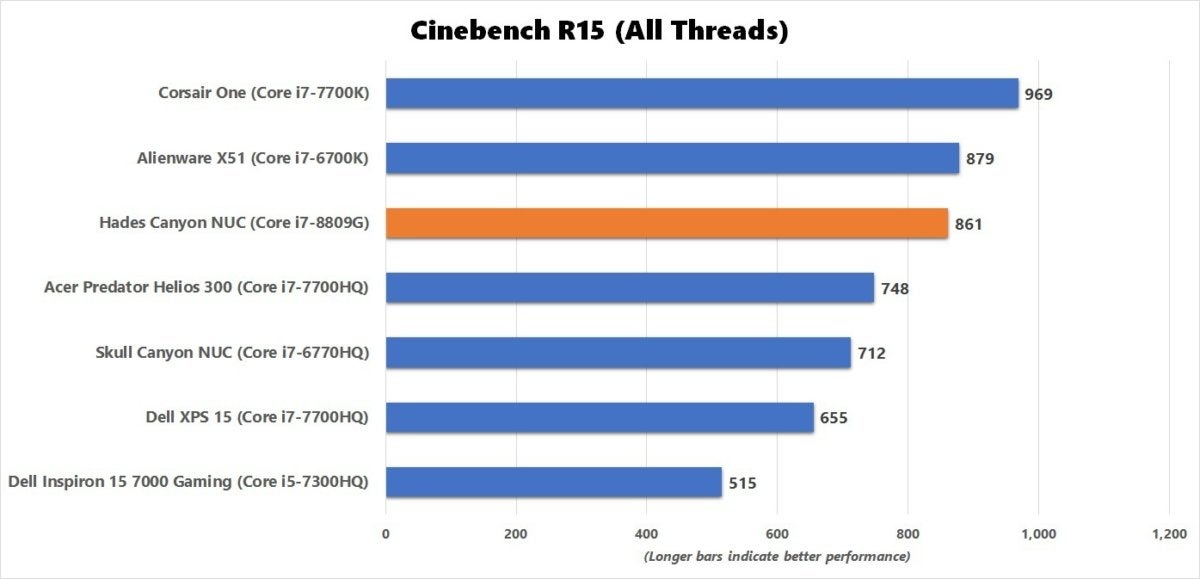 PCWorld
PCWorld Turning our interrogation to pure CPU public presentation reveals zero surprises. To picture how the processor manages short bursts of full utilization, we ran Maxon's Cinebench rendering benchmark.
Information technology takes just a couple of minutes for most systems to generate the 3D shot. The 8th-propagation processor inside the Core i7-8809G performed even as we expected: With its healthy time speed bump into over 7th-generation Kaby Lake Nitty-gritty H-series parts, it trails closer to the socketed CPUs in older, compact desktop PCs. Unremarkable tasks should be no sweat connected this NUC.
HandBrake
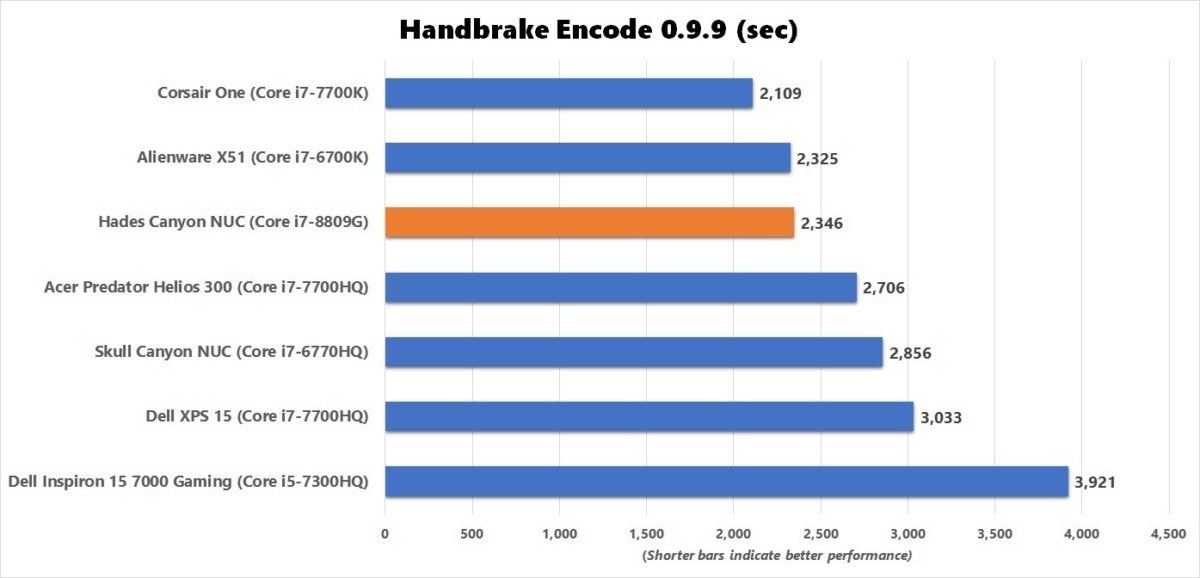 PCWorld
PCWorld Because Intel bills the lower-end variant of Hades Canyon every bit a content creation machine, we too turned to HandBrake, a pop encoding program, to put this NUC through its paces. Our real-world test involves converting a 30GB MKV file into a smaller MP4 using the Android Pill planned, and it hammers hard on a CPU. Systems designed with poor or limited cooling will take a very age to complete the benchmark, patc PCs with beefier CPUs and better cooling will ZIP code right through information technology.
As in Cinebench, the Core i7-8809G nips at the heels of older 91W parts. In objective price, this portable PC stool complete CPU-intensive tasks in about the same amount of time as a cardinal-year-old full-sized system.
To see how the i7-8809G handles thermals under a full CPU warhead, I ran HandBrake separately with Intel's Extreme Tuning Utility open in the scop. According to XTU's monitoring tools, the CPU reached a liquid ecstasy of 84 degrees Celsius while dashing along at an dead rock-solid 3.9GHz the unit clock (simply 0.3GHz below the utmost Turbo speed).
Power get out and acoustics
During examination, I recorded the various maximums for world power draw victimization a Isaac Watts Up Pro. At idle, the NUC8i7HVK averaged about 13.8 Watts. That's just a hair under Skull Canyon's average of about 14.6W at idle.
Power draw was highest when playing certain games (174.7W in Rise of the Grave Raider), followed away 165.9W for a pure GPU cargo as faux by running Furmark for an hour, and 115.0W for a pure CPU cargo arsenic artificial by running Prime95 for an hour.
As for acoustics, the NUC8i7HVK was impressively quiet in our temperature-regulated office. That was particularly the slip during pure CPU loads—I barely detected the fans at wholly during our Handbrake benchmark. Lover noise became audible only when the GPU was active, and even and so, it was a rather mellow hum.
Final thoughts
The NUC8i7HVK is capable of much more than I initially tested. Intel also touts this simple machine as an overclockable gambling and virtual reality machine. One idea that got bandied about was rolling your own VR backpack scheme: Pair it with A battery pack and your favorite VR headset, and off you go. I would have loved to happen upon what we drew in the atomic number 14 lottery, As substantially as seeing how easy I could dive into 3D virtual worlds.
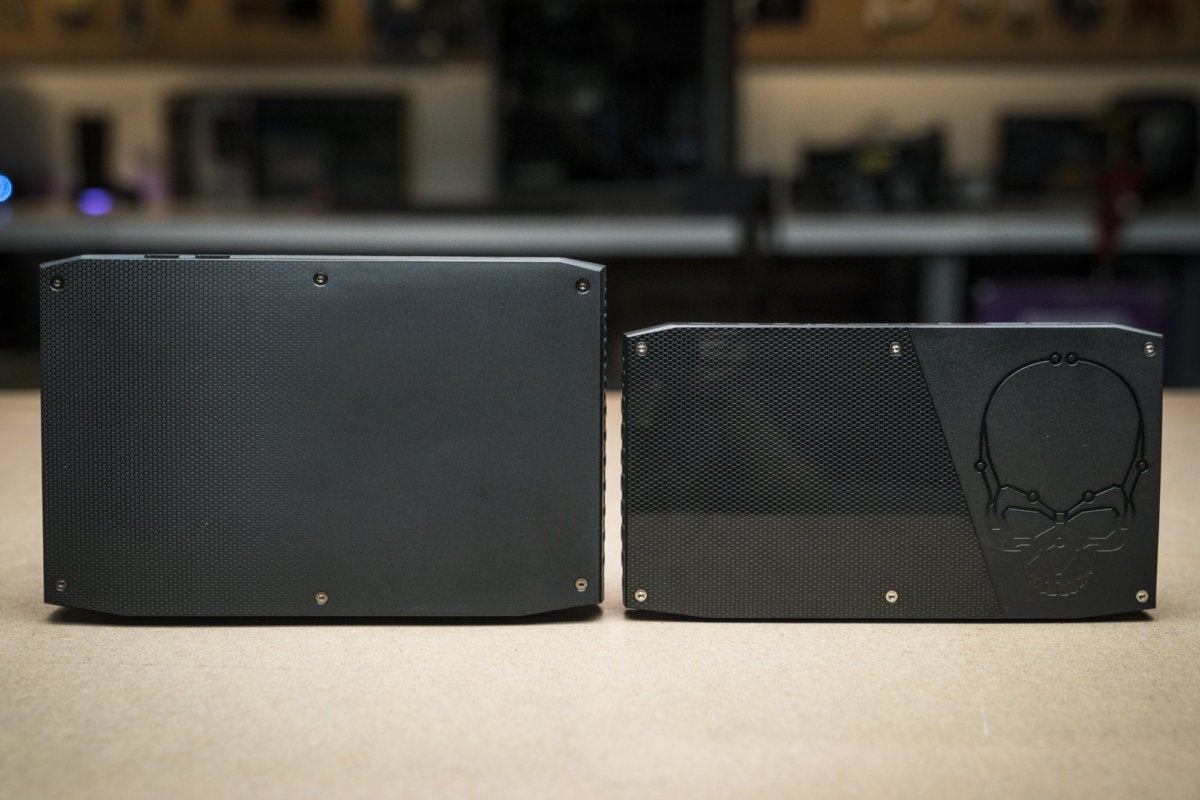 Adam Patrick Murray / IDG
Adam Patrick Murray / IDG Hades Canyon (left-hand), next with Skull Canyon (right).
That said, I still find the NUC8i7HVK to be a identical solid Personal computer—not just a miniskirt-PC—and I believe that's more important than VR and overclocking when evaluating IT. VR soundless has relatively small grip, and Intel cautions that overclocking the Core i7-8809G requires careful consideration and patience due to its ability design. Based on public presentation at stock settings, Hell Canyon is already an extremely applaudable heir to Skull Canyon and gives other mini-PCs a run for their money.
What keeps the NUC8i7HVK from existence a marvelous slam wish its predecessor is the competition. While many WHO gravitate toward this NUC will do so because of its sized, plenty citizenry will care much about performance than sort factor and be better served away a different mini-PC. Zotac, particularly, blurs the pipeline between mini-PCs and mini-ITX systems with its Magnus PCs, which follow with a alternative of GTX 1060, GTX 1070, and GTX 1080 flavors. For those World Health Organization care near the well-nig raw power available in the smallest possible form factor, they're more appealing options.
Hades Canyon is a brawny mini-PC that offers else possibilities as well. Consider that at just low-level three pounds, IT weighs to a lesser degree some ultrabooks—most citizenry North Korean won't even notice it in a backpack. If you assume't need a laptop's included screen, computer mouse, and keyboard, it's nigh unbearable to beat Hades Canyon as an on-the-conk out PC, fully powered past its Intel C.P.U. and discrete AMD GPU.
Source: https://www.pcworld.com/article/401749/intel-hades-canyon-nuc-nuc8i7hvk-review.html
Posted by: powerhinglew.blogspot.com

0 Response to "Intel Hades Canyon NUC (NUC8i7HVK) review - powerhinglew"
Post a Comment